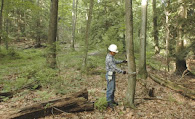DCNR Blog: New Resources Available For Forest Landowners And Managers For Climate Change Resilience
With the proper instruction, tools, and technical assistance, these landowners can manage their land in ways that enhance the production of wood, water, recreation, and wildlife and can mitigate the effects of a changing climate.
Making wise and informed decisions on how to manage land helps conserve the natural resources of Pennsylvania and ensure that forests are resilient and able to withstand future changes.
The DCNR Bureau of Forestry has been fielding an increasing volume of inquiries from private forest landowners and managers regarding climate change.
Some questions they ask include:
-- What climate change-related impacts are observable in my forest?
-- What should I be on the lookout for?
-- What species are expected to do well or suffer in a rapidly changing climate?
-- How can I enhance my forest’s resilience to climate change?
Climate Change Resilience Factsheets
The bureau has responded by producing a set of Managing for Forest Resilience fact sheets, each tailored to one of the four major ecoregions of Pennsylvania.
These include (county examples are given for orientation):
-- Ridge and Valley (Juniata, Northumberland, Carbon, Schuylkill, Huntingdon, Centre, Mifflin, Perry, Snyder, Union, Fulton, Bedford)
-- Western Allegheny (Westmoreland, Somerset, Fayette, Cambria, Indiana, Armstrong, Butler, Lawrence, Clarion, Venango, Jefferson, Greene, Washington, Mercer, Beaver)
-- Northern Allegheny (Warren, McKean, Potter, Clinton, Tioga, Lycoming, Bradford, Susquehanna, Wayne)
-- Piedmont (Adams, York, Lancaster, Lebanon, Berks, Bucks, Chester, Montgomery)
Each fact sheet has five major components:
-- A summary of observed and projected climate shifts in Pennsylvania
-- A list of climate change related forest threats and impacts
-- A list of actions forest owners/managers can take to encourage resilience to climate change
-- A list of vulnerable tree species
-- A list of species expected to be climate change resilient
Factsheets Available to the Public
Managing for Forest Resilience fact sheets are available at the following links:
[Visit DCNR’s Managing Your Woods webpage and the Penn State James C. Finley Center for Private Forests webpage for more on managing your woodlands sustainably.
[Visit Explore PA Trails and Get Outdoors PA for recreation areas near you.
[For more information on state parks and forests and recreation in Pennsylvania, visit DCNR’s website, Visit the Good Natured DCNR Blog, Click Here for upcoming events, Click Here to hook up with DCNR on other social media-- Facebook, Twitter, YouTube and Flickr.]
(Reprinted from DCNR’s Good Natured Blog.)
Related Articles:
-- Penn State Extension Hosts 9-Part Woods In Your Backyard Webinar Series Starting Jan. 11 [PaEN]
[Posted: October 19, 2022] PA Environment Digest




Comments
Post a Comment